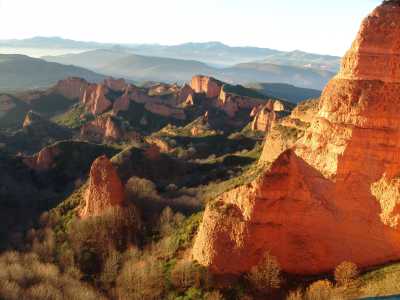Las Médulas used to be the most important gold mine in the Roman Empire
Las Médulas Cultural Landscape is listed by the UNESCO as one of the World Heritage Sites
The spectacular fantastical landscape of Las Médulas, northwest of the Aquilanos Mountains, in El Bierzo, Castilla y León, was left behind by the largest mining operation of the Roman Empire, an open air mine worked in the 1st and 2nd centuries AD, which is said to have extracted 800 tons of gold from the red rock of Las Médulas.

Las Médulas - Photo wikipedia
Their engineers used a technique known to Pliny the Elder as ‘Ruina Montium,’ literally ‘destroy the mountain,’ using the force of water to exploit the rich mineral resources of the area. It was an amazing feat of engineering which led Pliny to say when he first arrived there, ‘What happens in Las Médulas is far beyond the work of giants.’
The Roman engineers constructed a vast hydraulics network to channel water from as far away as 100 kilometres up the face of the mountains. There, the water was stored in large reservoirs until the sluice was opened to wash down the soil in a sudden rush of water – either along trenches or grooves cut into the mountain side - bringing with it the gold.
Another technique was applied within the mountains, where thousands of men dug galleries and channels out of the rock. There was only one exit – where the water was let in to bring down the mountain and release the gold-bearing rock as the enormous pressure caused the mountain to explode.
Pliny said in his Natural History, ‘The mountains are bored with corridors and galleries …. For months, the miners cannot see the sunlight and many of them die inside the tunnels. The cracks made in the entrails of the stone are so dangerous that it would be easier to find purpurine or pearls at the bottom of the sea than to make scars in the rock. How dangerous we have made the Earth!’
It was a massive operation, where the main pit covers more than 10 square kilometres, and the system of water channels extends for a total length of at least 100 kilometres.
The area was worked as a mine for more than two centuries, and was of great economic importance to the Roman Empire.
It had an enormous effect on the landscape – the wastes from the mines created artificial plains, and the lakes which can still be seen today which were formed by the waters used to wash the gold. There are even mounds of boulders scattered around - the rocks which had to be removed from the mountain by hand after the rushing waters brought down the galleries hewn from the stone. The sweet chestnut trees introduced by the Romans still flourish today, with their swathes of green making a striking contrast to the moon-like devastation of the mountains.
Today, Las Médulas has protection as a UNESCO World Heritage Cultural Landscape, granted in 1997 as ‘an outstanding example of innovative Roman technology, in which all the elements of the ancient landscape, both industrial and domestic, have survived to an exceptional degree.
Legends abound in Las Médulas. The Lago de Carucedo was one of the lakes which were left behind by the excavations, and there is a much more romantic tale to how it was formed: that it lies over a city whose king failed to keep his promise to hand his daughter in marriage to whichever of three brothers was the first to bring water to the city, by building a channel from the Río Cabrera. The brother who won, or so the story goes, worked backwards from the city, and connected his canal with the one his brothers were building from the river, and so was the first to complete the challenge. But he was lame, and the king went back on the deal, deciding that he would not be a fitting husband for his daughter. Soon after, the city was hit by a deluge of water, and the princess and all who lived in it were drowned.
https://www.spain.info/en/destination/las-medulas/
